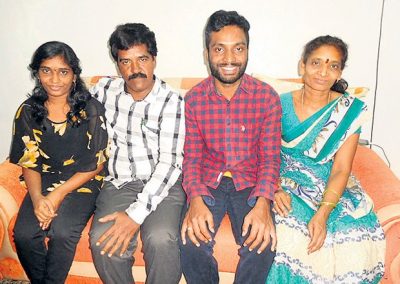The 17th-Century Dutch township of Bheemunipatnam is awash with history, but one that is slowly vanishing in the face of neglect
A winding road through one of the narrow lanes of Bheemunipatnam leads to a 17th-Century Dutch cemetery at Kummaripalem. One has to ask the locals how to get there as there is no signage. The oldest grave here is of Frederick Kesslerus, and according to the tombstone, he was buried here in 1661.
Most of the tombstones are overgrown with weeds and termite hills and are surrounded by broken bottles; the place is obviously a haven for anti-social elements.
When dusk falls, the cemetery is enveloped in darkness. In 1995, it was restored by S Samuel Roberts, a resident of the town, under the aegis of St Peter’s Church, Bheemunipatnam, with the aid of London-based British Association for Cemeteries in South Asia (BACSA).
Stained glass inside St. Peter’s Church, a heritage building built in 1864
Stained glass inside St. Peter’s Church, a heritage building built in 1864 | Photo Credit: K.R. Deepak
The State archaeology department is planning on some restoration.
“We will remove the debris and clear the wild growth around the tombstones. The work will be done in a week’s time,” says S Venkata Rao, assistant director, Department of Archaeology and Museums.
Restoration efforts
The department also wants to submit a proposal to the municipal authorities for street lighting around the cemetery.
On the Wishlist
A museum is the need of the hour.
Tourist brochures to give more inputs on the town’s history
Bheemunipatnam’s second-oldest cemetery is the Flagstaff Cemetery located opposite the Light House. The towering tombstones with words carved on them stand tall against the sky. Sometime back, the place was vandalised by miscreants who came in search of ‘hidden treasure’.
An attempt was made to give it a facelift, but that was a botched-up effort by the Tourism Department, as a result of which inscriptions have been painted over with paint, lime and plaster. On those that escaped there are still visible motifs of skulls and bones indicating the passage of power from the Dutch to the British.
Heritage activist Edward Paul says that Bheemunipatnam’s roots lie in these heritage structures, and unless these are protected and preserved, a rich history will fade away.
A view of the Dutch cemetery of 17th century at Bheemunipatnam in Visakhapatnam district
A view of the Dutch cemetery of 17th century at Bheemunipatnam in Visakhapatnam district | Photo Credit: K.R. Deepak
Seeking help
“BACSA used to provide financial aid for supporting the Dutch heritage structures. Efforts are being made to seek its assistance,” he says.
The St Peter’s Church, built in 1864, is another landmark heritage building that is undergoing restoration. There are also many ancient temples with a treasure trove of mythological stories.
The 18th century flagstaff cemetery in Bheemunipatnam, in Visakhapatnam district.
The 18th century flagstaff cemetery in Bheemunipatnam, in Visakhapatnam district. | Photo Credit: K.R. Deepak
A lost glory
Some heritage structures at Bheemunipatnam are already lost to the world.
Gali Meda, a magnificent building which was part of the Dutch Governor’s Bungalow, was demolished a few years ago. Maro Charitra ( Hindi version Ek Duuje Ke Liye) was shot here.
Kalyan Chakravarthy, a resident of Bheemunipatnam, says, “Many Britishers visit the town in search of their roots, but they go back disappointed after seeing the condition of the graves.”








